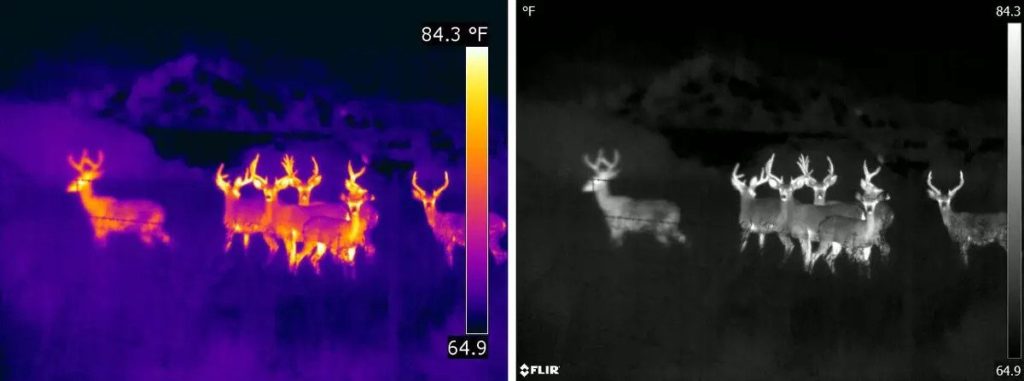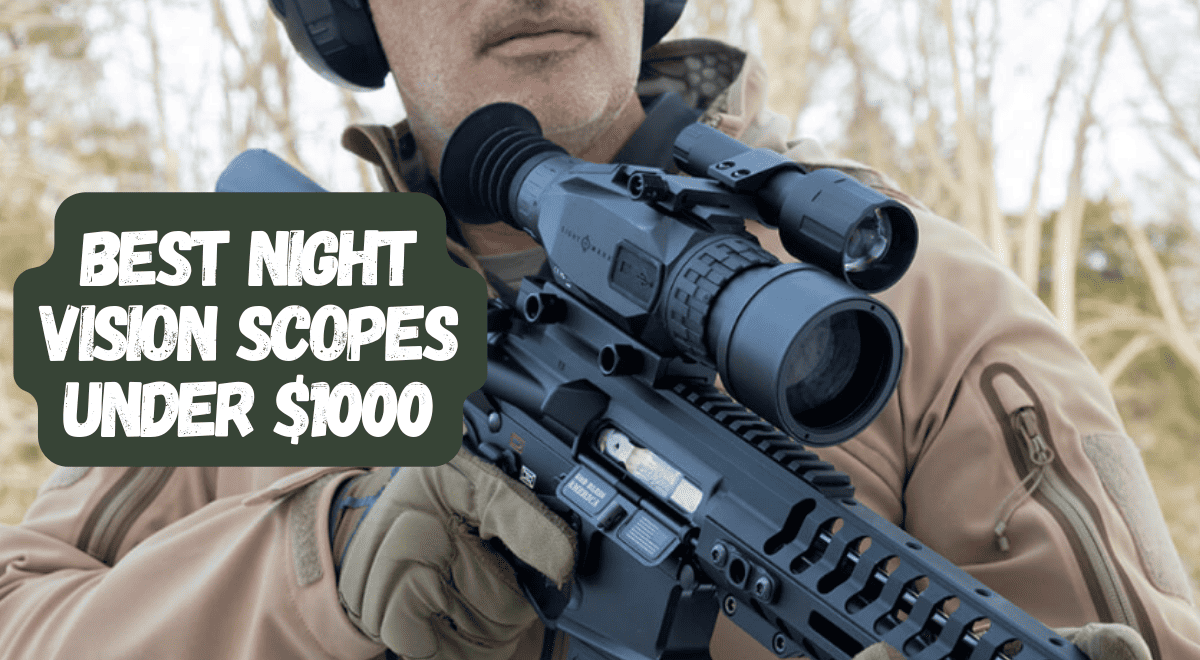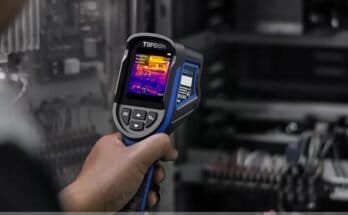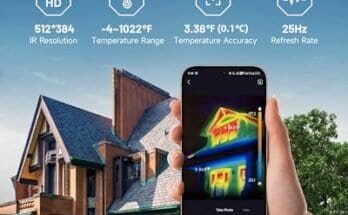Thermal imaging is superior for detecting game in total darkness, dense foliage, or inclement weather conditions. Night vision excels in low-light scenarios where some ambient light is present.
Selecting the right optic for hunting depends on environmental factors and personal preference. Night vision devices amplify existing light, making them ideal for situations where moonlight or starlight is available. These units are typically more affordable than thermal optics and provide detailed images of the surroundings, aiding in navigation and target identification.
On the other hand, thermal imagers detect heat signatures, allowing hunters to see through fog, smoke, and heavy vegetation where traditional night vision would be ineffective. This technology works day or night, offering versatility and a clear advantage for spotting game, even in the most challenging conditions. Understanding the strengths of each technology can ensure a successful and efficient hunting experience.
Night Vision And Thermal Imaging
When the sun sets and darkness covers the woods, hunters often rely on technology to track their game. Night vision and thermal imaging devices transform the night into day, giving hunters the upper hand. Understanding how each technology works helps determine which is better for hunting.
The Technology Behind Night Vision
Night vision devices amplify the smallest amounts of light. They turn the dimmest images into clear visuals. This technology relies on available light, like moonlight or starlight, to function.
- Photon Detectors: Night vision uses photon detectors to collect light.
- Image Enhancement: It enhances images by converting photons into electrons.
- Electron Multiplication: Electrons multiply to create a brighter version of the original scene.
The Science Of Thermal Imaging
Thermal imaging doesn’t need light. It detects heat and displays the temperature differences of objects. This allows hunters to see warm-blooded animals, even in total darkness.
- Heat Sensors: Thermal devices use sensors to detect heat signatures.
- Temperature Contrast: They translate temperature differences into clear visuals.
- Display Colors: Warm objects appear as whites or reds, while cooler objects are blues or purples.
Pros And Cons Of Night Vision For Hunting
Exploring the wilderness after the sun sets brings unique challenges for hunters. Choosing between night vision and thermal imaging involves weighing the benefits and drawbacks of each technology. Let’s delve into the pros and cons of using night vision for hunting.
Advantages Of Night Vision In The Wild
- Visibility in Low Light: Night vision devices amplify existing light, making it easier to see in near-dark conditions.
- Familiarity: Objects appear with clear detail, much like they do in daylight, which feels more natural to the eye.
- Cost-Effective: Generally cheaper than thermal, night vision provides an accessible option for many hunters.
- Battery Life: These devices often boast longer battery lives, extending time in the field.
Limitations When Using Night Vision Gear
- Dependence on Light: Without ambient light or an infrared illuminator, night vision is less effective.
- Visibility Issues: Dense fog, heavy rain, or thick brush can obscure the view.
- Camouflage Effect: Animals with good cover can easily blend in, making them tough to spot.
- Narrow Field of View: Some night vision scopes offer a limited perspective, restricting situational awareness.
Thermal Imaging Strengths For Hunters
When the sun sets, hunters with thermal imaging get an edge. This tech lets hunters see what’s otherwise invisible to human eyes. It detects heat, giving a clear view in total darkness. It’s not just about seeing in the dark, though. Thermal imaging has unique strengths that make it a top choice for hunters.
Detecting Heat Signatures In Darkness
Thermal cameras excel at finding warm subjects against cooler backgrounds. They spot game from far distances, even at night. Unlike night vision, thermal doesn’t need light to work. It creates images from heat.
- Animals can’t hide their heat. Cover won’t mask their presence.
- No reliance on moonlight or stars, complete darkness is fine.
- Hunters see through smoke and dust as well.
Thermal Imagery Through Obstructive Conditions
Fog, branches, and foliage can block views. Not for thermal imaging. It sees through them to detect temperature contrasts. This tech picks out targets in tough conditions, where others fail.
| Condition | Thermal Imaging | Night Vision |
|---|---|---|
| Heavy Fog | Good detection | Reduced clarity |
| Dense Brush | Can see through | Often blocked |
| Complete Darkness | Clear image | Depends on available light |

Credit: butlerandland.com
Comparing The Effectiveness
Comparing the Effectiveness of night vision and thermal imaging is crucial for hunters. Both technologies offer unique benefits. The right choice can enhance the hunting experience. This section evaluates the performance of night vision and thermal devices.
Clarity And Detail: Night Vision Vs. Thermal
Night vision uses available light to create a clear image. Stars and moonlight help a lot. It displays the world in a green hue. People see through darkness like daytime. However, details can get lost in shadows or thick foliage.
Thermal imaging, on the other hand, detects heat signatures. It works in complete darkness and through obstructions. It turns heat into visible images. But, details like facial features or patterns are less visible with thermal.
| Technology | Clarity | Detail |
|---|---|---|
| Night Vision | High with ambient light | Fine details visible |
| Thermal Imaging | Works in total darkness | Focuses on heat patterns |
Range And Detection: Finding The Edge
Range is a critical factor for hunters. It determines how far they can see and identify targets. Night vision typically has a shorter range. Thermal imagers surpass night vision [when distance matters].
Detection capabilities of thermal devices are superior. They can reveal hidden game in challenging conditions. Night vision can struggle with camouflage or foliage.
- Night Vision:
- Limited range in darkness
- Struggles with camouflage
- Thermal Imaging:
- Longer detection range
- Effective through barriers
Field Applications And Real-world Scenarios
Choosing between night vision and thermal imaging for hunting can be tough. Each technology offers unique benefits in the field. It depends on what you’re hunting, where, and when.
Hunter Testimonials And Case Studies
Night vision and thermal scopes have transformed hunting expeditions. Here are some stories from the field:
- A deer hunter prefers thermal imaging to spot hidden game in dense foliage.
- A hog hunter in Texas reported success using night vision under a bright moon.
These stories show it’s not just about gear, but how and when you use it.
Versatility In Diverse Environments
Both technologies excel in different settings:
| Technology | Woodlands | Open Fields | Weather Conditions |
|---|---|---|---|
| Night Vision | Good | Excellent | Clear Nights |
| Thermal Imaging | Excellent | Good | Fog, Smoke |
In woodlands, thermal works better, cutting through clutter. Open fields suit night vision if there’s light.
Making The Right Choice
Making the Right Choice between night vision and thermal imaging for hunting is crucial. The decision can impact your success in the field. Consider the environment, the game you’re pursuing, and the specific hunting conditions when choosing your gear. This section will guide you through evaluating your hunting needs and conducting a cost-benefit analysis to help you determine the best option for your hunting adventures.
Evaluating Your Hunting Needs
- Target Species: Certain animals are easier to spot with specific technologies.
- Habitat Type: Dense foliage may require different devices.
- Time of Day: Night vision excels in low light, not total darkness.
- Personal Experience: Your comfort with technology matters.
- Legal Restrictions: Know the laws in your hunting area.
Understanding these factors ensures you pick the right tool. Both night vision and thermal imagers have their own strengths. Night vision amplifies light and works well when some ambient light is present. Thermal imaging detects heat signatures, proving more effective in complete darkness or obstructed views.
Cost-benefit Analysis
| Parameter | Night Vision | Thermal Imaging |
|---|---|---|
| Initial Cost | Generally less expensive | More expensive tech |
| Operating Conditions | Requires some light | Effective in all light conditions |
| Durability | Often more rugged | Sensitive to harsh use |
| Detection Range | Limited by light | Superior range abilities |
A closer look at costs and benefits helps solidify your decision. Assess the upfront investment against long-term value. Consider maintenance costs, durability, and versatility in various environments. Night vision might save money upfront, but if thermal imaging results in more successful hunts, it may offer greater value in the long term.

Credit: www.shootingillustrated.com
Frequently Asked Questions
What Are The Key Differences Between Night Vision And Thermal?
Night vision amplifies available light to create a visible image, whereas thermal imaging detects heat signatures, turning them into a picture. Night vision requires some light to operate effectively; thermal imaging can work in complete darkness or through obscurants like smoke or fog.
Is Thermal Imaging Or Night Vision Better For Hunting?
For hunting, thermal imaging is often favored as it can detect animals by their heat signatures, even in dense vegetation or complete darkness. However, night vision might be preferred in lighter conditions or when you need more detailed images.
Can Night Vision Devices See Through Fog And Smoke?
Generally, night vision devices struggle with obstructions like fog and smoke because they rely on amplifying existing light. They cannot ‘see’ through these obscurants effectively, unlike thermal imaging devices which can.
How Do Weather Conditions Affect Night Vision And Thermal?
Thermal imaging devices are less affected by weather conditions, as they detect temperature differences rather than light. On the other hand, heavy rain, fog, or snow can limit the functionality of night vision devices by reducing available light or creating glare.
Conclusion
Deciding between night vision and thermal imaging for hunting is not one-size-fits-all. Your choice hinges on environment, quarry, and personal preference. Night vision excels in dimly lit conditions, while thermal is unmatched for heat detection. Match the gear to your goals for a successful hunt.
Happy tracking!



